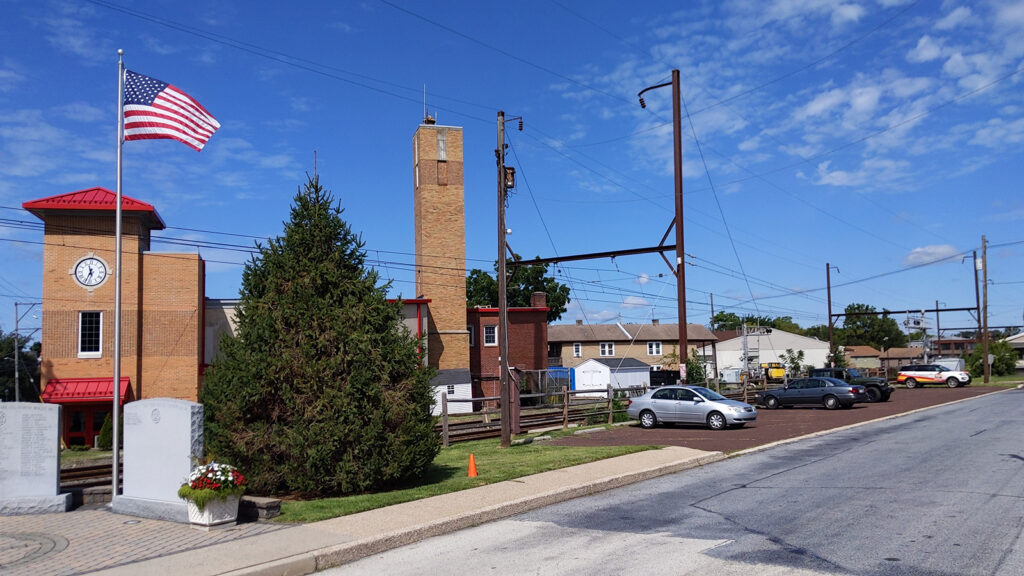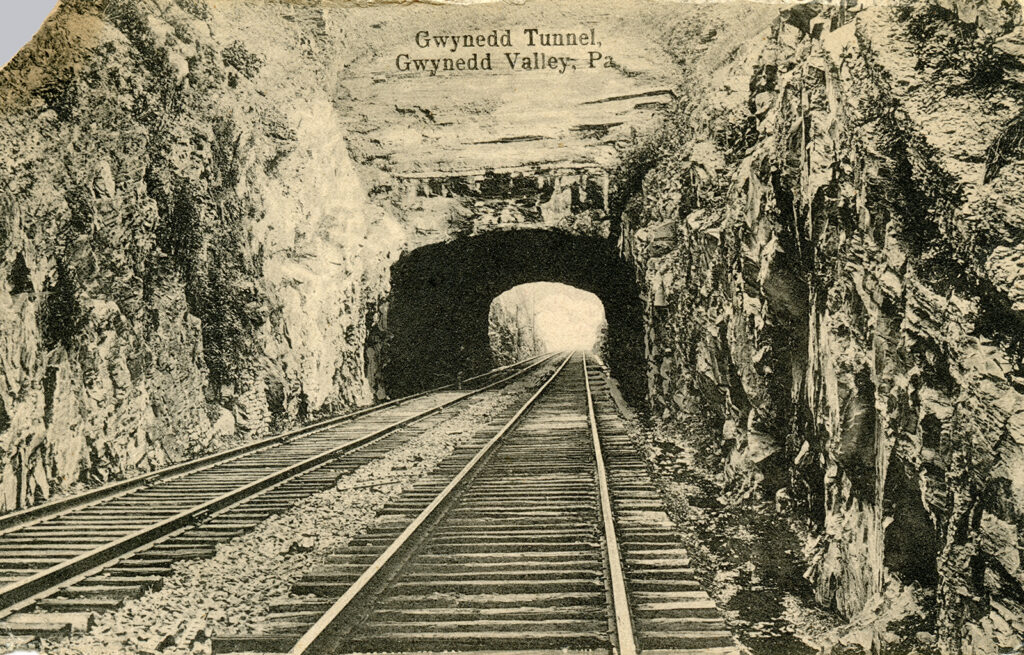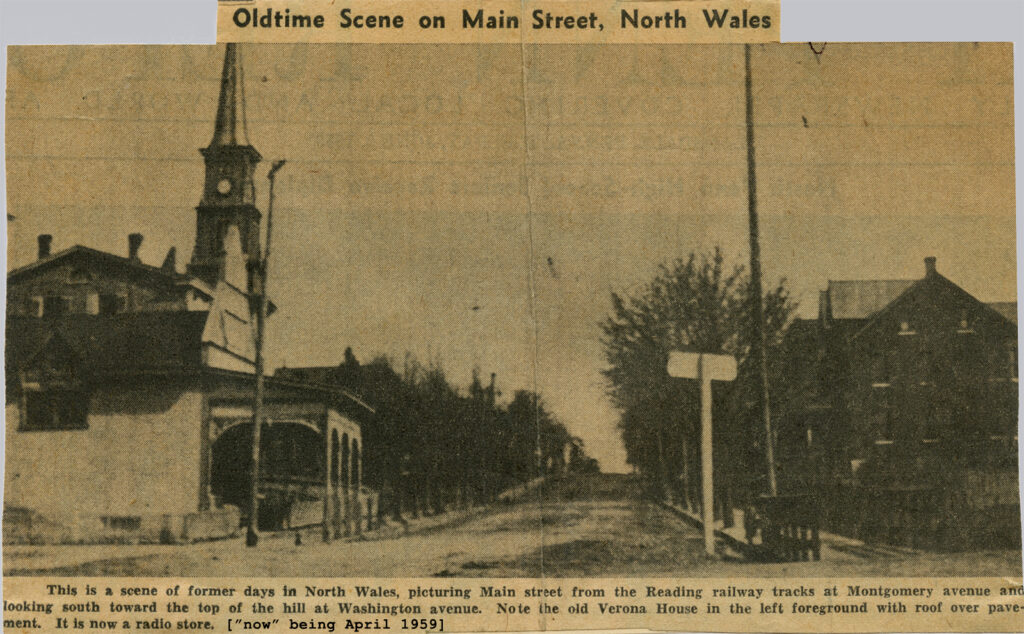That the North Penn Railroad was welcome in the 1850’s, is evident from the fact that a site for a depot was given to the railroad company. Algernon S. Jenkins donated the piece of ground between the railroad and E. Montgomery Avenue, between Main and Second Streets. The original train station is long gone, and today the site is occupied by North Penn Volunteer Fire Company’s parking lot.

Two decades later (1873) the new North Wales railroad station was built a quarter mile north of the original station, on the west side of the tracks between E. Walnut Street and Beaver Street. (The 1873 train station is still in use today.)
The coming of the railroad was a boon to North Wales, and spurred many changes in the vicinity. In 1856 the North Penn Railroad was completed from 3rd & Berks Street in North Philadelphia, as far as Gwynedd. A temporary terminal was established at what is now known as Gwynedd Valley.
The completion of the Gwynedd tunnel, located one mile south of what would become North Wales, was the obstacle to the completion of the railroad. The following is quoted from the Philadelphia Inquirer of July 3, 1855, which reports the opening of the railroad to Gwynedd:
“About a mile [north of] Gwynedd, the railroad passes through a cut 60 feet deep, and then a tunnel 500 feet in length, which is now nearly finished, 260 men being there at work, the incessant blasting of rocks sounding like the explosions of heavy artillery.”
Philadelphia Inquirer, July 3, 1855

After two years of arduous effort, in 1857 the North Penn Railroad opened between Philadelphia and Bethlehem, Pennsylvania.
[So, what happened to the tunnel? In 1930, in order to provide space for the overhead catenary electric wires that still power trains today, the Reading Railroad removed the rock tunnel roof, a process known as “daylighting.” See postcard view of the tunnel, above.]
Our present Main Street was part of an Indian trail, and was laid out in 1728. In 1730 the Swedesford Road, intersecting the Pike at Gwynedd, was laid out. The early records show that Robert Evans, of North Wales, was Justice of the Peace in 1726, and his map mentions Acuff’s Tavern (now William Penn Inn). There was also a hotel, kept by George Heist in 1784, where the Pike crosses Haines-Dittingers Creek.
At the crossroads we know as Prospect Avenue and S. Main Street, was the Old Yellow Church, occupied by both the Lutheran and Reformed congregations. In the cemetery stood a small schoolhouse for pay scholars, and on Sundays it was used for vocal singing classes. When the public schools were established the old schoolhouse was used as a tenement.
North Wales first public schoolhouse was erected on the southwest corner of N. Main Street and Elm Avenue (at that time, Elm Avenue was called W. School Street). Today this corner is occupied by an office building “on stilts,” with parking underneath. The schoolhouse was a two-story stone building 24’ 6” by 36’ 6”, with a well of good and lasting water and a number of shade trees. The grounds included two new frame buildings measuring 7’ by 8’ 6” by 7 feet high, and a coal box. Pupils sat on wooden benches, some made of slab wood and some of cord wood. Each day the boys cut wood to heat the school. This building served North Wales students until the new school on E. School Street opened. The old school building was sold on August 4, 1877.
At the Hurst homestead [on S. Main Street opposite Shearer Street] was a distillery, where apple-jack [apple brandy] was made and sold for six cents a quart. A glass cost three cents with two cigars thrown in, which were called rye-straws. In 1857 this farm was sold, the farmhouse being rebuilt as a hotel. We will deal with the history of this hotel [North Wales Hotel] in a later article.
East of the railroad, the Verona House was erected on the northeast corner of S. Main Street and Montgomery Avenue. Circa 1959 a radio and television store occupied the front part of this building. This three story building was erected in 1858 by Charles Losher, who kept an inn here until 1866. It was then sold to John Bush. Bush remained two years, when in 1868 he conveyed it to George Cathrell, who turned it into a private dwelling.

Opposite the schoolhouse on N. Main Street was the farmhouse of Daniel Kenderdine, and beyond that lay the farm of Frederick Beaver. Opposite the school building on School Street was a skating pond. Along Beaver Street were several large groves which were the scenes of many picnics.
In 1860 the first new house was erected, being the house at 107 N. Second Street. Coal yards, stores, cigar factories, shoe and harness shops, and blacksmiths all came and did a thriving business.
The following tidbits of wisdom appeared in our local paper, the North Wales Record, in March 1895:
Just why a spoony couple would rather sit on the stairs than on the softest sofa in the parlor is one of those things no feller can find out.
Never accuse a man of insobriety when he slips on your orange peel.
This post is sourced from a column entitled Early North Wales: Its History and Its People penned by long-time North Wales resident historian Leon T. Lewis. The article appeared in its original form in the April 28, 1959 issue of the North Penn Reporter.
